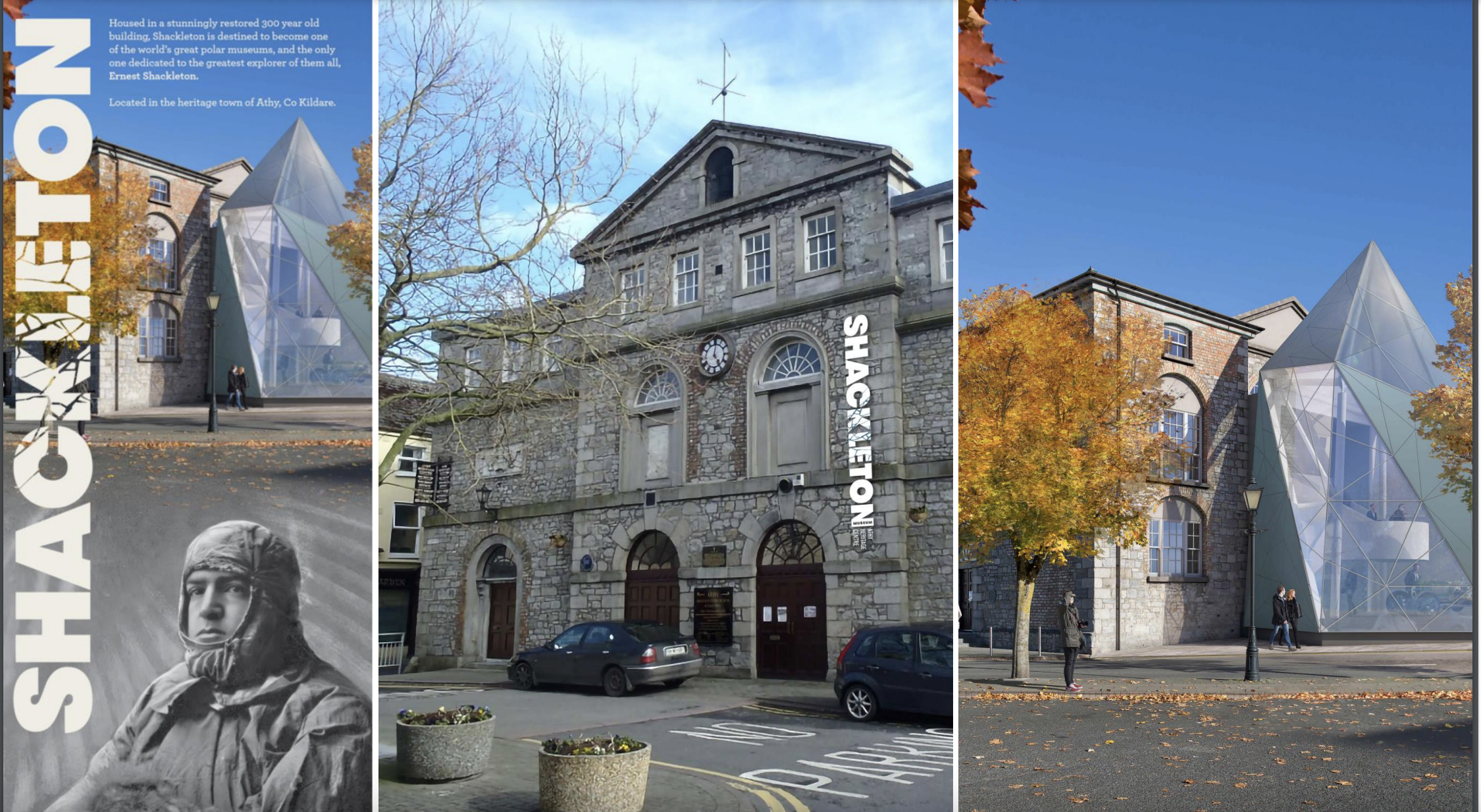Sir Ernest Shackleton, the great polar explorer, was born in Kilkea House, Kilkea, five miles from Athy, Co. Kildare, on 15 February 1874. Coming from an Anglo-Irish background with a strong Quaker heritage, he is renowned for his courage and extraordinary leadership skills on the legendary 1914–16 Endurance expedition to the Antarctic.
His first expedition was as a member of Captain Robert Falcon Scott’s expedition to the Antarctic in 1901–3. He led his own expedition to the Antarctic on the whaling ship Nimrod in 1909 and came within 97 miles of reaching the South Pole, the ‘furthest south’ at the time. Shackleton decided to turn back rather than risk the lives of his men. He is said to have commented to his wife on his return that ‘It’s better to return a live donkey than a dead lion’. He was knighted by the king on his return from that expedition.
In 1914 Shackleton commenced his third trip to the Antarctic, setting sail with 27 men on the Endurance. On 19 January 1915 the ship was ice-bound, and when it was crushed the following October it had to be abandoned. The crew camped on a drifting ice floe for five months before undertaking a fearful seven-day voyage in open boats to the uninhabited and desolate Elephant Island. Shackleton then embarked on his most desperate gamble—to sail with five men in a 22ft lifeboat, the James Caird, across 1,500km of sea to the nearest point of civilisation at South Georgia. It has been described as one of the greatest open-boat journeys of all time. At sea for seventeen days, they landed on the island’s uninhabited coast. Shackleton, with Captain Frank Worsley and Second Officer Tom Crean (from County Kerry), marched across the unmapped, treacherous terrain to Stromness whaling station, the first civilisation they had encountered in seventeen months. From there, Shackleton was eventually able to rescue every expedition member. On 5 January 1922 he died of a heart attack on South Georgia Island, where he is buried.
The motto of the Irish branch of the Shackleton family was Fortitudine vincimus, ‘By endurance we conquer’. Originally from Yorkshire, Abraham Shackleton, a Quaker, was the first of the family to settle in Ireland in the eighteenth century. He opened a multi-denominational school in the Quaker village of Ballitore (thirteen miles from Athy) in 1725. This school was to become known as the Eton of Ireland and was to educate such notable figures as the parliamentarian and philosopher Edmund Burke and the revolutionary James Napper Tandy. Ernest Shackleton was brought up an Anglican; his grandfather, Ebenezer Shackleton, had defected from Quakerism, as he considered that they had become lax. Nevertheless, it could be argued that some of the leadership qualities demonstrated by Ernest Shackleton on the Endurance expedition can be attributed to this Quaker family heritage. In particular, Shackleton treated all his men equally, regardless of rank or class, a feature typical of the Quaker philosophy.
Ernest’s father, Henry, was a farmer in Kilkea, Co. Kildare. He married Henrietta Letitia Sophia Gavan in 1872. Ernest was the second child and eldest son of a family which would eventually number eleven children. The family moved from Kilkea to Dublin in the 1870s and then to London in 1884. At the age of sixteen, Shackleton was eager to pursue a career at sea and joined the mercantile marines as an apprentice.
Although he left Ireland at the age of ten (and Kilkea four years before that), Roland Huntford, Shackleton’s biographer, maintains that Shackleton always remained an Irishman abroad. Called ‘Micky’ at school in Dulwich College, London (apparently there was already a boy called ‘Paddy’), the young Shackleton’s Irish accent worked against him, as he was often set aside by his English classmates. One St Patrick’s Day, he and a fellow Irish pupil were compelled by their schoolmates to have a fight in honour of the sacred memory of St Patrick! He was known to use his ‘very Irish capacity to grip an audience’, telling fantastical stories of why he was late for class or did not produce his homework on time.
At present under development in Athy, Co. Kildare, is a new visitor experience/museum dedicated to Ernest Shackleton. The mission is for it to be one of the world’s great polar museums and become a national and international reference point for a heroic age of exploration. The centre will be an international tribute to the world’s greatest polar explorer. The development is being funded through the Rural Regeneration Development Fund and is scheduled to open in June 2025. Located on Dublin’s doorstep in the heritage town of Athy, and housed in a 300-year-old building overlooking Emily Square, it will showcase the most prominent collection of Shackleton memorabilia in the world.
View plans for the museum here: https://ejiyc3kucb5.exactdn.com/wp-content/uploads/2024/11/Shackleton-Visuals.pdf.

